Discover the Top 20 World-Class Hiking Adventures in 2024
- March 27, 2024
- 0 comment
Explore the top 20 hiking trails of 2024: handpicked for their breathtaking views, unique terrains, and unforgettable experiences worldwide. In 2024, the world’s top 20 hiking trails offer unmatched experiences for every adventurer. From the serene beauty of ancient forests to the stark majesty of mountain peaks, this guide connects you with trails that not only challenge and inspire but also provide a gateway to the world’s natural wonders.
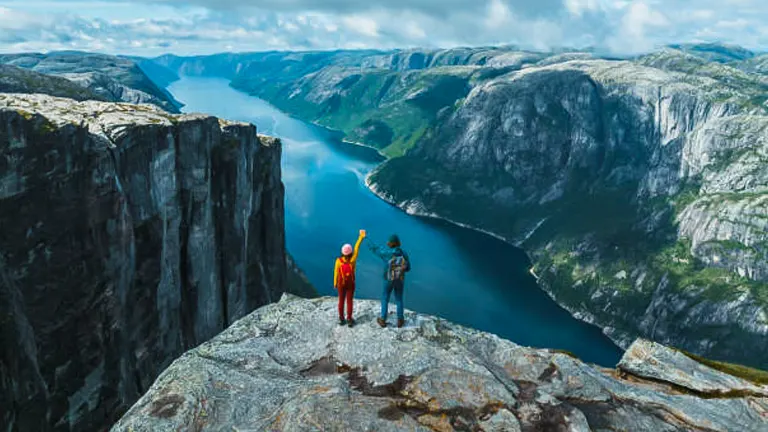
Each selection is based on its scenic beauty, the challenge it presents, and its accessibility to hikers of all levels. Prepare to embark on journeys that are as enriching as they are exhilarating, with trails that cater to both the seasoned explorer and the enthusiastic novice, promising unforgettable adventures and the opportunity to witness the unparalleled beauty of our planet.
List of Top 20 World-Class Hiking Adventures in 2024
- Tongariro Alpine Crossing
- Inca Trail to Machu Picchu
- Tour du Mont Blanc
- Petra Through the Back Door
- John Muir Trail
- The Lycian Way
- The Great Ocean Walk
- Annapurna Circuit
- West Highland Way
- The Kalalau Trail
- The Camino de Santiago
- The Snowman Trek
- Fitz Roy Trek
- Everest Base Camp Trek
- The PCT (Pacific Crest Trail)
- Laugavegur Trail
- The Routeburn Track
- Kilimanjaro Trek
- Dolomites High Route 1
- The W Trek
The Evolution of Hiking in Recent Years
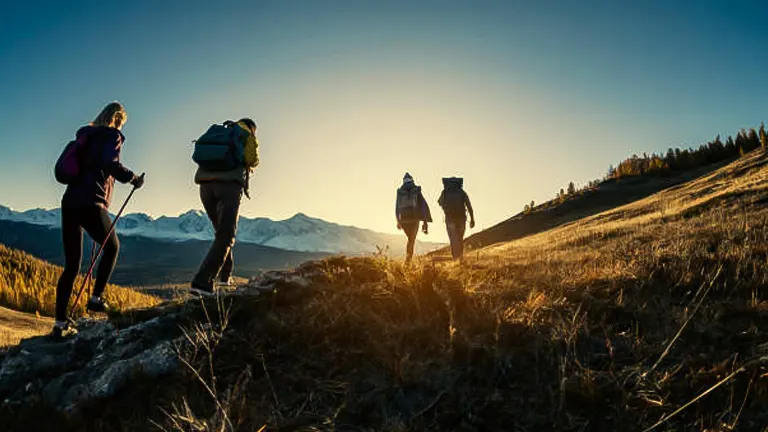
Hiking has transformed significantly, thanks to technological advancements in gear, growing global interest in outdoor activities, and the broadening of social media’s reach. Modern equipment has become more sophisticated, offering hikers greater comfort and safety. Moreover, the rising awareness of the health and psychological benefits of spending time outdoors has encouraged more people to take up hiking. Social media platforms have played a crucial role in highlighting lesser-known trails, making remote hikes more accessible. Despite these changes, the essence of hiking remains the same: a pursuit of adventure and a deep respect for nature.
The global community has also rallied to make trails more accessible while prioritizing the conservation of natural habitats. Efforts to maintain and protect hiking trails ensure that these outdoor experiences remain sustainable and available for future adventurers.
Criteria for Selecting the Top 20 World-Class Hiking Adventures in 2024
- Scenic Beauty and Uniqueness: Each trail offers breathtaking natural landscapes that are not only visually stunning but also possess unique characteristics. This might include extraordinary geological formations, rare ecosystems, or panoramic views that are unmatched anywhere else in the world.
- Cultural and Historical Significance: Some trails offer more than just natural beauty; they are imbued with rich cultural or historical significance, providing hikers with a deeper connection to the land and its people. This includes trails that traverse ancient trade routes, sacred paths, or areas of historical importance.
- Biodiversity: Trails that pass through areas of significant biodiversity, offering hikers the opportunity to witness a wide array of flora and fauna, are particularly valued. This criterion highlights the importance of conservation efforts and the chance to experience wildlife in its natural habitat.
- Challenge and Accessibility: The list includes trails that cater to a range of physical abilities and experience levels, from moderate hikes that are accessible to most healthy individuals to more challenging treks that require advanced preparation and physical fitness. This diversity ensures that there’s something for everyone, from seasoned adventurers to those new to long-distance hiking.
- Sustainability and Conservation Efforts: Trails that are maintained with a focus on sustainability and minimal environmental impact are prioritized. This includes well-managed paths that encourage responsible tourism practices, support local conservation efforts, and help preserve the natural beauty of the area for future generations.
- Seasonal Accessibility: Trails that offer optimal hiking conditions at specific times of the year were chosen to provide readers with a year-round selection of adventures. This ensures that regardless of when you plan to embark on your hiking journey, there are world-class trails accessible and in their prime.
- Global Representation: The selection aims to represent a variety of continents and climates, showcasing the incredible diversity of the planet’s landscapes. From the icy reaches of Patagonia to the lush forests of Southeast Asia, the list provides a global perspective on the world’s best hiking experiences.
- Traveler Feedback and Popularity: Trails that have consistently received positive feedback from the hiking community for their beauty, challenge, and overall experience were considered. Popularity is balanced with the trail’s ability to manage visitor numbers to prevent over-tourism and environmental degradation.
The Top 20 World-Class Hiking Adventures in 2024
1. Tongariro Alpine Crossing – New Zealand
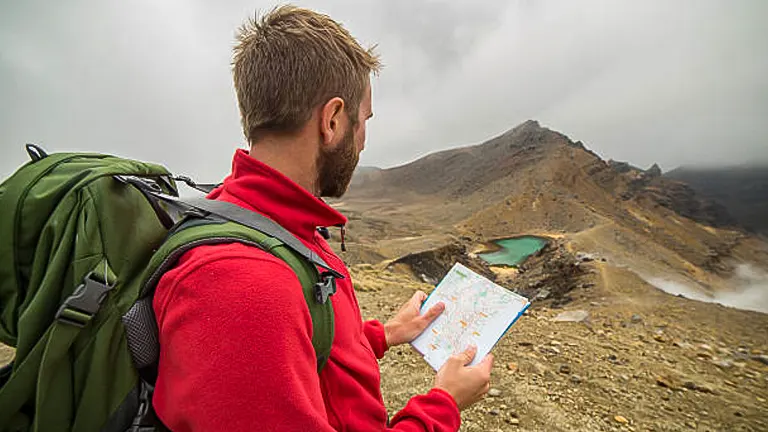
The Tongariro Alpine Crossing in New Zealand is celebrated as one of the most stunning one-day treks available worldwide. This hike offers an otherworldly landscape of craters, colorful lakes, and volcanic peaks, including the iconic Mt. Ngauruhoe, famously known as Mount Doom in the Lord of the Rings films. Hikers are treated to a challenging but rewarding journey through the heart of the North Island’s Tongariro National Park, a dual World Heritage site recognized for both its natural and cultural significance.
- Location: Tongariro National Park, North Island, New Zealand
- Distance: Approximately 19.4 kilometers (12 miles)
- Best Time to Visit: Late spring to early autumn (November to April) for the most stable weather conditions
- Difficulty Level: Moderate to challenging
- Special Features: Emerald Lakes, Blue Lake, and the Red Crater
- How to Get There: The closest major towns are Taupo and Turangi, with access to the park via State Highway 1.
2. Inca Trail to Machu Picchu – Peru

The Inca Trail to Machu Picchu is not just a trek but a journey back in time, tracing the footsteps of the Inca civilization to the mystical city of Machu Picchu. This trail combines breathtaking natural beauty, encompassing cloud forests, mountain passes, and diverse ecosystems, with the rich history and archaeological sites of the Incan people. The culmination of the trek at the awe-inspiring Machu Picchu is a moment that stays with hikers forever.
- Location: Cusco Region, Peru
- Distance: Approximately 43 kilometers (26 miles)
- Best Time to Visit: May to September for dry weather; permits are required and should be booked months in advance due to limited availability.
- Difficulty Level: Moderate to challenging
- Special Features: Ancient Incan ruins, Wiñay Wayna, the Sun Gate
- How to Get There: Most travelers start in Cusco, where you can join guided tours that handle logistics and permits.
3. Tour du Mont Blanc – Europe

Tour du Mont Blanc is one of Europe’s premier hiking experiences, circling the Mont Blanc massif through France, Italy, and Switzerland. This multi-day trek is renowned for its stunning alpine scenery, diverse cultural experiences as it passes through three different countries, and the camaraderie found in the trail’s numerous refuges and mountain huts. The path offers panoramic views of glaciers, peaks, and verdant valleys, making it a bucket-list adventure for many.
- Location: France, Italy, Switzerland
- Distance: Approximately 170 kilometers (105 miles)
- Best Time to Visit: June to September for optimal weather conditions
- Difficulty Level: Moderate to challenging
- Special Features: Views of the Mont Blanc massif, Alpine meadows, and traditional villages
- How to Get There: The traditional starting point is Chamonix, France, easily accessible from Geneva, Switzerland, with regular bus and train services.
4. Petra Through the Back Door – Jordan
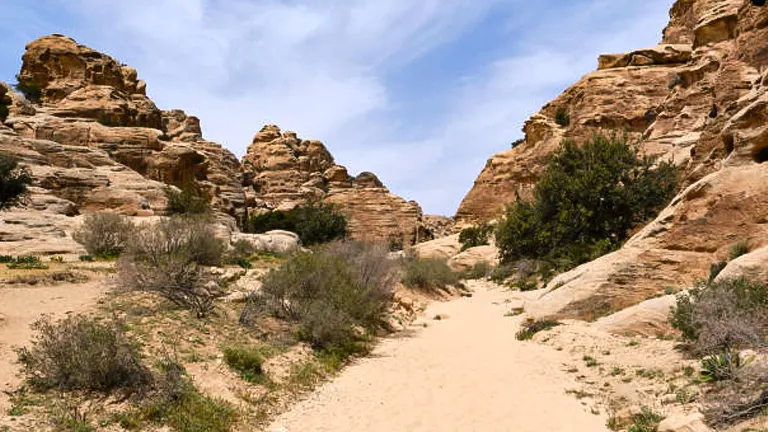
Hiking to the ancient city of Petra via the back door route offers an extraordinary perspective on one of the world’s most stunning archaeological sites. This path allows hikers to avoid crowds and experience the breathtaking beauty of Petra’s monuments as they emerge from the desert landscape. The journey through narrow gorges and desert landscapes ends with the majestic view of the Monastery, rivaling the famous Treasury as Petra’s most impressive facade.
- Location: Petra, Jordan
- Distance: Approximately 8 kilometers (5 miles)
- Best Time to Visit: March to May and September to November when the weather is mild and enjoyable
- Difficulty Level: Moderate
- Special Features: The Monastery, ancient rock-cut architecture, and less-traveled paths
- How to Get There: Most travelers stay in Wadi Musa or nearby towns. The back door route typically starts from Little Petra, a short drive from Wadi Musa.
5. John Muir Trail – USA
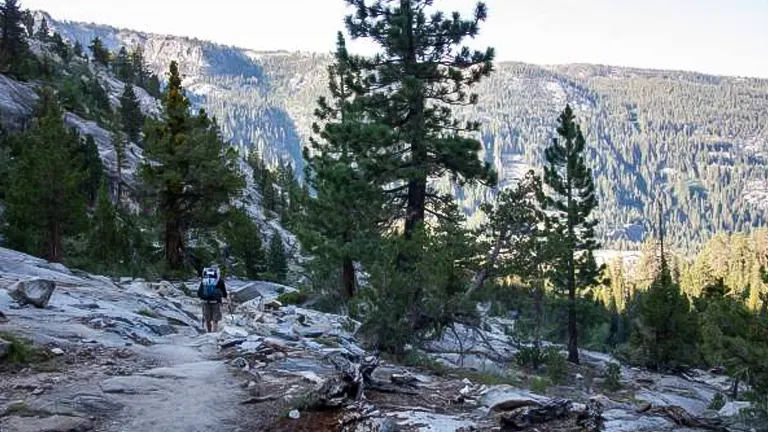
The John Muir Trail (JMT) traverses through the heart of the Sierra Nevada mountain range in California, offering some of the most picturesque landscapes in the United States. This trail is a tribute to the natural beauty of the High Sierras, passing through Yosemite, Kings Canyon, and Sequoia National Parks. Hikers on the JMT encounter a variety of terrains, from lush meadows and serene lakes to rugged mountain passes and granite cliffs.
- Location: California, USA
- Distance: Approximately 340 kilometers (211 miles)
- Best Time to Visit: July to September, when the snow has melted, and the trails are most accessible
- Difficulty Level: Challenging
- Special Features: Yosemite Valley, Mount Whitney, the Ansel Adams Wilderness
- How to Get There: The northern terminus is in Yosemite National Park, while the southern end is at Mount Whitney. Access is typically through nearby towns such as Mammoth Lakes or Lone Pine.
6. The Lycian Way – Turkey
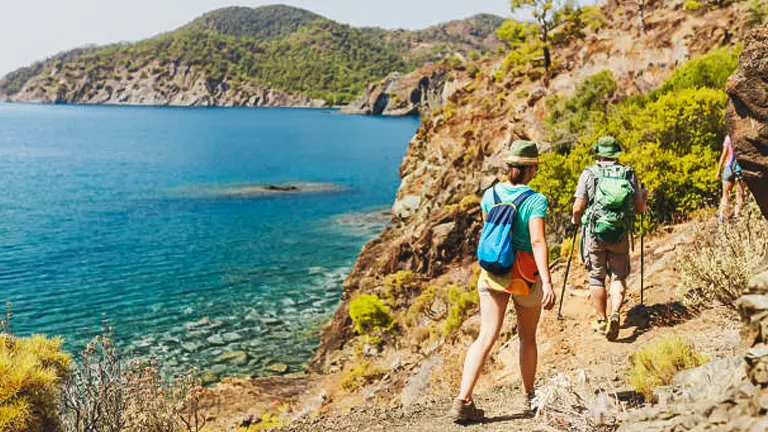
Turkey’s Lycian Way offers an exquisite blend of turquoise coastlines, ancient ruins, and rugged mountain scenery. This long-distance footpath takes hikers along the southern coast of Turkey, through landscapes that tell stories of ancient civilizations. The trail offers not just natural beauty but also a deep dive into the region’s rich history, with stops at Lycian tombs, Roman cities, and secluded beaches.
- Location: Southern Coast of Turkey
- Distance: Approximately 540 kilometers (335 miles)
- Best Time to Visit: Spring (March to May) or Autumn (September to November) for mild weather and fewer tourists
- Difficulty Level: Moderate to challenging
- Special Features: Patara Beach, ancient Lycian ruins, Mount Olympos
- How to Get There: The trailhead starts in Fethiye. Dalaman Airport is the nearest, with bus services to Fethiye.
7. The Great Ocean Walk – Australia
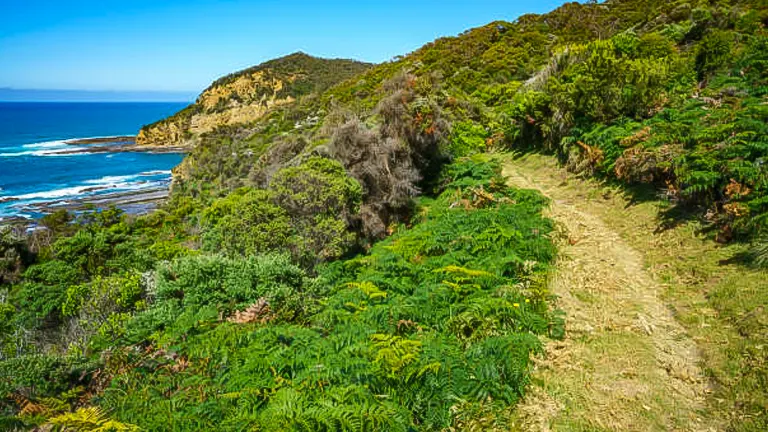
The Great Ocean Walk, stretching along the picturesque Victorian coast, offers hikers the chance to experience Australia’s raw coastal beauty. From its start in Apollo Bay to the iconic Twelve Apostles, the trail meanders through national parks, deserted beaches, and rugged cliff tops, providing panoramic views of the Southern Ocean. This walk is a journey through diverse ecosystems and the perfect way to experience the dramatic landscapes that define Australia’s coastline.
- Location: Victoria, Australia
- Distance: Approximately 100 kilometers (62 miles)
- Best Time to Visit: September to May, avoiding the winter months for more comfortable hiking conditions
- Difficulty Level: Moderate
- Special Features: Twelve Apostles, Otway National Park, shipwreck history
- How to Get There: Apollo Bay, the starting point, is accessible by car or bus from Melbourne.
8. Annapurna Circuit – Nepal

The Annapurna Circuit is a globally renowned trek that encapsulates the natural and cultural diversity of Nepal. Circumnavigating the Annapurna massif, this trail offers hikers an in-depth look at the life in the Himalayas, from subtropical forests and terraced rice paddies to high mountain passes and Buddhist monasteries. The Thorong La Pass, the circuit’s highest point, presents a challenging yet rewarding endeavor, showcasing panoramic views of the Himalayas.
- Location: Annapurna Region, Nepal
- Distance: Approximately 160-230 kilometers (100-145 miles), depending on the chosen route
- Best Time to Visit: March to April and October to November for clear skies and moderate temperatures
- Difficulty Level: Challenging
- Special Features: Thorong La Pass, hot springs, Poon Hill viewpoint
- How to Get There: The journey typically begins in Besisahar or Bhulbhule, accessible by bus or jeep from Kathmandu or Pokhara.
9. West Highland Way – Scotland
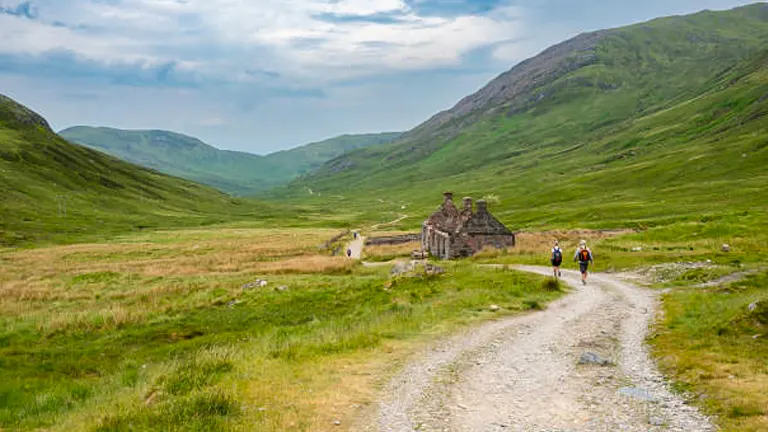
Scotland’s West Highland Way is a testament to the rugged beauty of the Scottish Highlands. Stretching from the outskirts of Glasgow to the foot of Ben Nevis, Britain’s highest peak, this trail traverses serene lochs, dense woodlands, and open moorlands, offering hikers a taste of Scotland’s iconic landscapes. The trail’s relatively gentle terrain makes it accessible to hikers of various skill levels while providing ample challenges for those seeking them.
- Location: Scotland, United Kingdom
- Distance: Approximately 154 kilometers (96 miles)
- Best Time to Visit: May to September, with longer daylight hours and milder weather
- Difficulty Level: Moderate
- Special Features: Loch Lomond, Rannoch Moor, Glencoe
- How to Get There: Starting from Milngavie, easily reached by train or bus from Glasgow.
10. The Kalalau Trail – Hawaii, USA
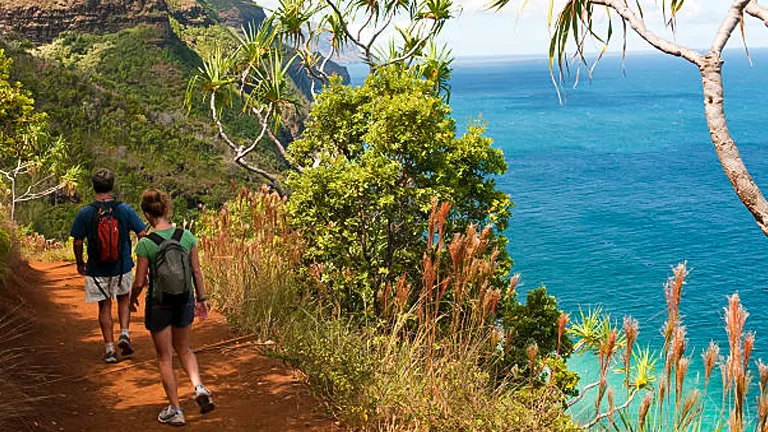
The Kalalau Trail offers an immersive experience into the rugged beauty and sheer cliffs of Kauai’s Na Pali Coast. This trail is famed for its challenging terrain, stunning sea cliff views, and access to secluded beaches. The journey through lush valleys and along high ridges is a rewarding endeavor for those prepared to tackle its narrow paths and occasional stream crossings. Due to its remote nature and difficulty, permits are required for camping and to hike beyond Hanakāpīʻai Beach.
- Location: Kauai, Hawaii, USA
- Distance: Approximately 35 kilometers (22 miles) round trip
- Best Time to Visit: May to October, when the trail is driest and weather conditions are most stable
- Difficulty Level: Challenging
- Special Features: Hanakāpīʻai Falls, Kalalau Beach, sea cave explorations
- How to Get There: The trailhead is located at Ke’e Beach at the end of Kuhio Highway (Route 560) on Kauai’s north shore.
11. The Camino de Santiago – Spain

The Camino de Santiago, or the Way of St. James, is more than just a hike; it’s a pilgrimage that has been undertaken by millions over centuries. The route, stretching across Spain to the shrine of the apostle Saint James the Great in the Cathedral of Santiago de Compostela, offers various paths, with the French Way being the most popular. This trek is as much a spiritual journey as it is a physical one, bringing together people from all walks of life.
- Location: Various routes across Spain
- Distance: Varies; the French Way is about 780 kilometers (484 miles)
- Best Time to Visit: Spring (April to June) and Autumn (September to October) to avoid the extreme heat of summer and the crowded peak season
- Difficulty Level: Moderate
- Special Features: Historic towns, vineyards, Romanesque churches
- How to Get There: The French Way starts in Saint-Jean-Pied-de-Port, France, accessible from major cities in France and Spain via train or bus.
12. The Snowman Trek – Bhutan

The Snowman Trek is often cited as one of the most difficult treks in the world, traversing remote and stunning landscapes of the Bhutanese Himalayas. This expedition takes hikers through untouched mountain villages, high-altitude passes, and close to some of the highest unclimbed mountains in the world. The trek requires a high level of fitness and acclimatization to altitude, offering an unparalleled challenge for even the most experienced adventurers.
- Location: Bhutan
- Distance: Approximately 200-300 kilometers (124-186 miles), depending on the specific route
- Best Time to Visit: September to November, for clear weather and less snow on high passes
- Difficulty Level: Very challenging
- Special Features: Laya Village, high-altitude Himalayan passes, Jomolhari mountain views
- How to Get There: The trek usually starts in Paro, where the international airport is located. All visitors to Bhutan must travel as part of a guided tour arranged through a Bhutanese tour operator.
13. Fitz Roy Trek – Argentina
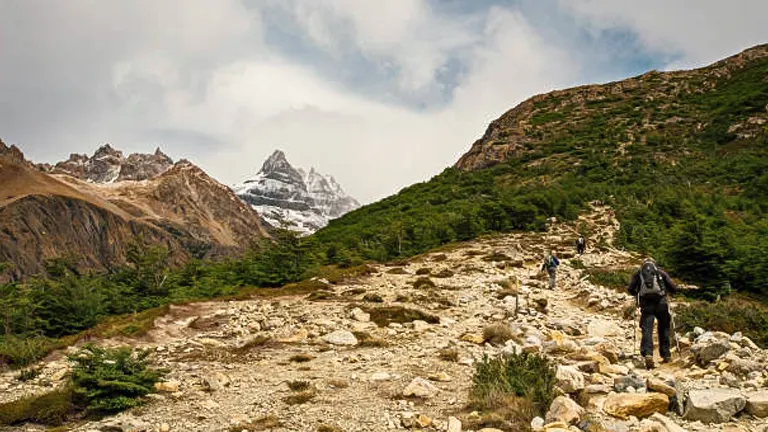
The Fitz Roy Trek in Patagonia, Argentina, captivates hikers with its jaw-dropping mountain scenery, pristine lakes, and glaciers. This trek is accessible from the small town of El Chaltén and offers various trails that lead to stunning viewpoints of Mount Fitz Roy, Cerro Torre, and the Southern Patagonian Ice Field. The routes range from day hikes to more extended treks, allowing for flexibility in planning.
- Location: Patagonia, Argentina
- Distance: Various; day hikes to multi-day treks available
- Best Time to Visit: November to April, the Southern Hemisphere’s summer months, offer the best weather conditions.
- Difficulty Level: Moderate to challenging
- Special Features: Laguna de los Tres, Cerro Torre, ice trekking on Viedma Glacier
- How to Get There: El Chaltén is the trekking hub, accessible by road from El Calafate, where the nearest airport is located.
14. Everest Base Camp Trek – Nepal
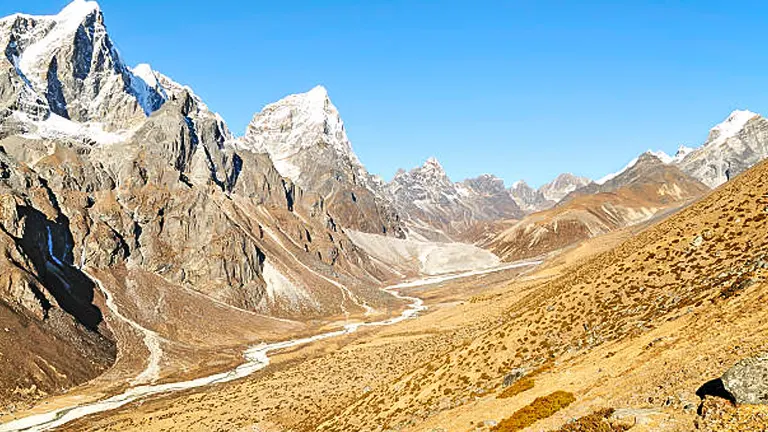
The Everest Base Camp Trek is a legendary expedition offering unparalleled views of the world’s highest peak. This trek takes hikers through the heart of the Nepalese Himalayas, with stops at Sherpa villages, Buddhist monasteries, and awe-inspiring viewpoints. Reaching the base camp itself is a momentous achievement, surrounded by the majestic Himalayan peaks.
- Location: Khumbu Region, Nepal
- Distance: Approximately 130 kilometers (80 miles) round trip
- Best Time to Visit: March to May and October to November for clear skies and safer travel conditions.
- Difficulty Level: Challenging
- Special Features: Namche Bazaar, Tengboche Monastery, Kala Patthar viewpoint
- How to Get There: The trek typically starts with a flight to Lukla from Kathmandu, followed by several days of hiking.
15. The PCT (Pacific Crest Trail) – USA
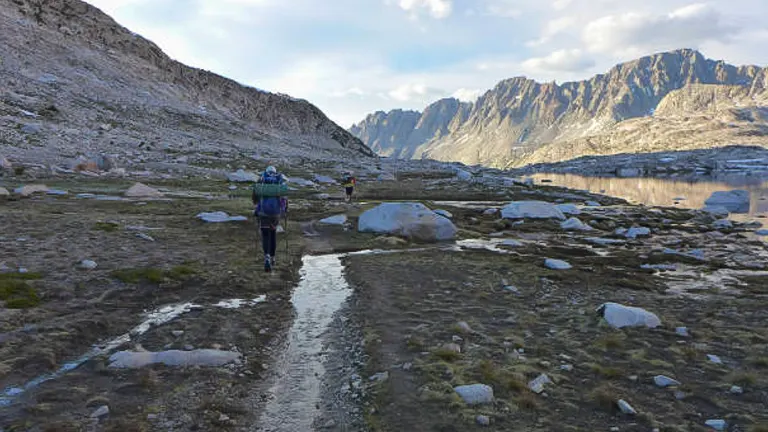
Stretching from the Mexican border in California to the Canadian border in Washington, the PCT traverses some of the most stunning landscapes in the American West. This long-distance trail offers a diverse range of environments, from the deserts of Southern California to the alpine conditions of the Sierra Nevada and the volcanic landscapes of Oregon and Washington.
- Location: California, Oregon, Washington, USA
- Distance: Approximately 4,265 kilometers (2,650 miles)
- Best Time to Visit: The timing varies depending on the section; generally, late spring through early fall is optimal.
- Difficulty Level: Challenging to very challenging, depending on the section
- Special Features: Yosemite National Park, Crater Lake, the Sierra Nevada
- How to Get There: Access points vary widely; many hikers start at Campo, California, near the Mexican border.
16. Laugavegur Trail – Iceland
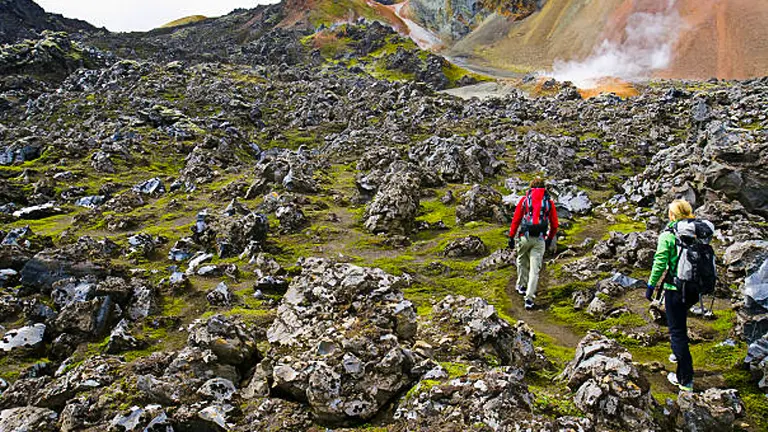
The Laugavegur Trail is Iceland’s most famous trek, known for its otherworldly landscapes that include rhyolite mountains, geothermal hot springs, and vast lava fields. This trek connects the Landmannalaugar region to Þórsmörk, traversing through some of Iceland’s most unique and colorful landscapes.
- Location: Iceland
- Distance: Approximately 55 kilometers (34 miles)
- Best Time to Visit: July to September, when the trail is mostly snow-free and accessible
- Difficulty Level: Moderate
- Special Features: Landmannalaugar’s geothermal area, Fimmvörðuháls volcano, Þórsmörk valley
- How to Get There: Buses run to Landmannalaugar and Þórsmörk from Reykjavík during the trekking season, providing easy access to the trailheads.
17. The Routeburn Track – New Zealand

The Routeburn Track is one of New Zealand’s Great Walks, offering a journey through diverse landscapes of the South Island. This track takes hikers through ancient forests, alpine flora, and high mountain passes, with panoramic views over the Southern Alps and Fiordland National Park. The track connects Mount Aspiring National Park with Fiordland National Park, showcasing some of the most dramatic scenery in the country.
- Location: South Island, New Zealand
- Distance: Approximately 33 kilometers (20.5 miles)
- Best Time to Visit: November to April, during the Southern Hemisphere’s summer, for the best hiking conditions
- Difficulty Level: Moderate
- Special Features: Key Summit, Earland Falls, panoramic views of the Hollyford Valley
- How to Get There: The eastern end of the track is near Te Anau, and the western end is near Glenorchy, both accessible by road from Queenstown.
18. Kilimanjaro Trek – Tanzania

Climbing Mount Kilimanjaro, Africa’s highest peak, is a feat that combines physical challenge with the reward of spectacular views above the clouds. The journey to the summit takes you through five distinct climate zones, from rainforest to arctic conditions at the peak. With several routes to choose from, climbers can decide their path based on scenery, difficulty, and personal preference.
- Location: Kilimanjaro National Park, Tanzania
- Distance: Varies by route; approximately 70 kilometers (43 miles) on the Marangu Route
- Best Time to Visit: January to March and June to October, with clearer skies and less precipitation
- Difficulty Level: Challenging
- Special Features: Uhuru Peak, the highest point in Africa; unique flora and fauna across climate zones
- How to Get There: Most climbers fly into Kilimanjaro International Airport, with treks typically starting in Moshi or Arusha, where many tour operators are based.
19. Dolomites High Route 1 – Italy
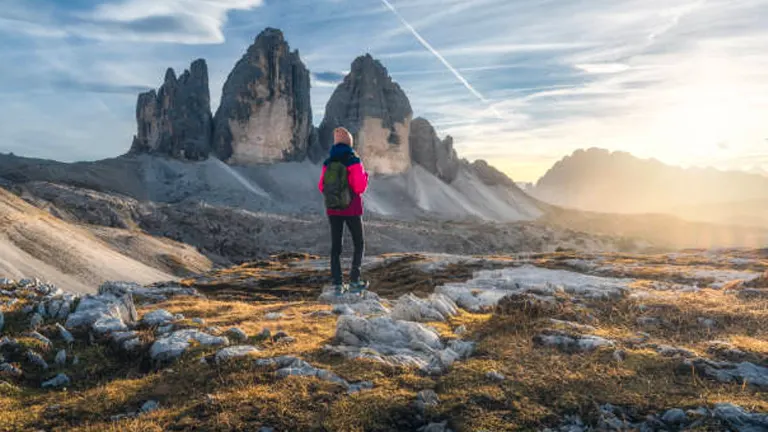
Known in Italian as Alta Via 1, the Dolomites High Route 1 offers one of Europe’s most picturesque treks, winding through the stunning mountain scenery of the Dolomites. This trail is famed for its breathtaking vistas of towering peaks, alpine meadows, and serene lakes. Hikers can enjoy the unique blend of Italian and Austrian cultures in the region, with excellent mountain huts along the route providing warm hospitality.
- Location: Dolomites, Italy
- Distance: Approximately 120 kilometers (75 miles)
- Best Time to Visit: June to September, when the weather is most stable and the trails are snow-free
- Difficulty Level: Moderate
- Special Features: Cinque Torri, Lagazuoi tunnels, views of Marmolada glacier
- How to Get There: The trail typically starts at Lago di Braies in the north and ends at Belluno in the south. Access is easiest from Venice or Innsbruck, with local transport options to the trailheads.
20. The W Trek – Torres del Paine, Chile
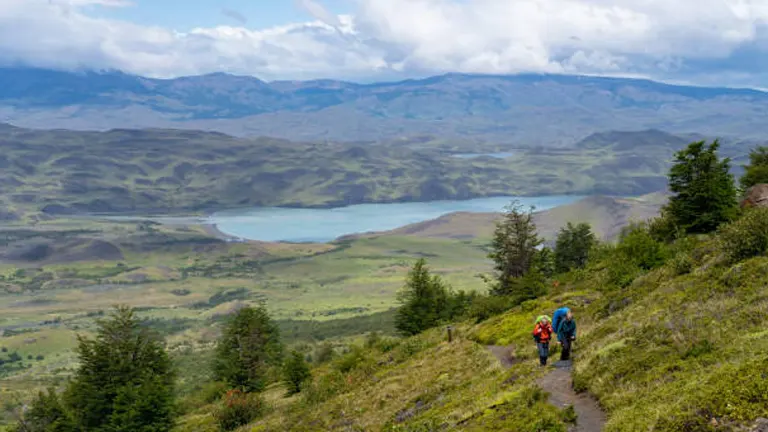
The W Trek in Torres del Paine National Park is a world-renowned trek that showcases the best of Patagonian natural beauty. Named for its W-shaped route, this trek takes hikers past glaciers, towering granite peaks, and turquoise lakes. This trail is a showcase of the dramatic landscapes that define southern Chile and offers a variety of ecosystems, wildlife, and breathtaking vistas.
- Location: Torres del Paine National Park, Chile
- Distance: Approximately 80 kilometers (50 miles)
- Best Time to Visit: November to early March, during the Southern Hemisphere’s summer for optimal weather
- Difficulty Level: Moderate
- Special Features: Grey Glacier, French Valley, the Base Torres lookout
- How to Get There: The nearest major city is Punta Arenas, with regular bus services to Puerto Natales and onward to Torres del Paine National Park.
Essential Gear and Preparation for 2024 Hiking
Proper preparation and gear are the backbones of a successful hiking adventure. Sustainable and durable equipment is not only a matter of safety but also a step towards environmentally conscious hiking. Essential items for 2024 include lightweight and eco-friendly backpacks, water filtration systems to minimize bottled water use, and versatile clothing suitable for changing weather conditions. Footwear, crucial for comfort and safety, should be selected based on the trail’s terrain.
Physical readiness is equally important. Regular cardio, strength training, and flexibility exercises will prepare your body for the rigors of hiking. Additionally, familiarizing yourself with basic navigation skills, first aid, and the principles of Leave No Trace will enhance both your experience and the well-being of the trails you visit.
Conclusion
The world is brimming with breathtaking trails that offer hikers the opportunity to explore diverse landscapes, from the icy summits of Kilimanjaro to the rugged beauty of Patagonia and the ancient paths of the Camino de Santiago. Each trail offers a unique adventure, challenging hikers to push their limits while providing rewarding experiences and unforgettable views. As you plan your hiking adventures for 2024, consider these top 20 world-class hiking adventures, each with its own story to tell and beauty to unveil. Whether you seek solitude, adventure, or the thrill of reaching new heights, these trails promise to enrich your life and leave you with lasting memories.
FAQs
- How did the concept of “world-class” hiking adventures evolve with the pandemic?
The pandemic shifted many hikers’ priorities towards less crowded, more remote trails, increasing the value of outdoor experiences that offer both solitude and connection with nature. World-class now emphasizes sustainability, safety, and the ability to provide transformative experiences away from the usual tourist trails. - What technological advancements have most impacted hiking adventures in recent years?
GPS technology, lightweight materials for gear, and apps for trail maps and weather forecasts have significantly impacted hiking. These advancements make remote trails more accessible and safer, enhancing the overall hiking experience by offering better preparation and comfort. - Can you recommend a hike from the list that is particularly meaningful for solo travelers?
The Camino de Santiago stands out for solo travelers. It’s not just a hike; it’s a journey through history and culture, offering a sense of community and self-discovery that many solo adventurers seek. The trail’s well-marked paths and network of hostels provide both independence and opportunities to meet fellow hikers. - What initiatives are in place to ensure the sustainability of these top hiking destinations?
Many of these destinations now implement permit systems, limit daily visitors, and enforce Leave No Trace principles to minimize environmental impact. Additionally, local conservation efforts often involve communities in maintaining trails and protecting natural habitats to ensure sustainability. - How can hikers best prepare for the physical challenges of these trails?
Beyond regular fitness training, hikers should focus on conditioning hikes that mimic the terrain and altitude of their planned adventure. Incorporating strength training, especially for the lower body and core, can also help. Practicing with a loaded backpack and the exact gear planned for the hike is crucial for preparation. - What role does local culture play in these hiking adventures?
Local cultures enrich the hiking experience by offering unique insights into the history, cuisine, and traditions of the area. Many of these trails, such as the Inca Trail and the routes in Bhutan, are deeply intertwined with the cultural heritage of the local communities, making respect and understanding a vital part of the journey. - How are these hiking adventures making a positive impact on local economies?
Responsible hiking tourism supports local economies by providing income through lodging, guides, porters, and local artisan products. Many hikers are encouraged to engage with local businesses and services, fostering a beneficial relationship that values and preserves local traditions and environments. - What is the most unexpected challenge hikers might face on these trails, and how can they prepare for it?
Beyond physical challenges, hikers often find mental and emotional resilience to be equally critical. Preparing for solitude, dealing with unexpected weather conditions, and navigating language barriers can be challenging. Mental preparation, learning basic phrases in the local language, and carrying essential communication devices can help mitigate these challenges.
Explore our dedicated section on national forests and state parks to uncover hidden gems and outdoor wonders. Discover top recommendations in our best section, and delve into in-depth product reviews in our review section.
We’re excited to hear about your world-class hiking adventures! Drop your stories, insights, and unforgettable experiences in the comments below. Let’s build a community of explorers and conservation enthusiasts devoted to appreciating and protecting these magnificent natural wonders.

Benjamin Brooks
Forestry AuthorGreetings! I'm Benjamin Brooks, and my journey over the past 15 years has revolved around the fascinating realms of content creation, expertise in snow clearing, and the intricate world of lumberjacking and landscaping. What began as a simple curiosity about the natural world and heavy machinery has evolved into a passionate profession where my love for crafting words intertwines seamlessly with my lumberjacking and garden skills.













Leave your comment